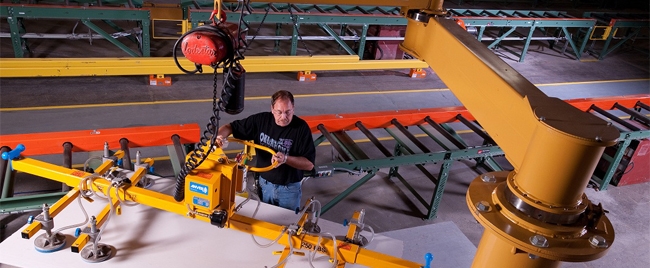Related: Jib Cranes & Overhead Cranes
Overhead cranes are the lead actor in fabrication, manufacturing and repair facilities, but one should not forget about the supporting actor the Jib Crane. Jib cranes help to fulfil an important niche, and when combined with an overhead crane, they can create an extremely productive workplace.
What is a Jib Crane?
One of the most mechanically simplest cranes used, jib cranes have three major components:
Masts the vertical support structure, this allows for the boom to be held at the correct angle.
Booms or Jibs: the horizontal member, this supports the moveable hoist; this is the part that is fixed to the floor or wall.
Trolleys: this sits horizontally back and forth along with the boom and holds the hoist, wire rope and lifting hook.
Jib cranes are broken down into two main categories floor-mounted and wall-mounted cranes, with the floor-mounted cranes being attached to a fixed support base and wall-mounted cranes being attached to a structural support or wall.
Often times jib cranes are permanently mounted into place, but small jib cranes can be mounted to vehicles, unfortunately, these can only be used for lightweight tasks. Often times though jib cranes are only assigned tasks that are within their boom radius.
Advantages of Jib Cranes:
Though they are simple in design jib cranes are important pieces of equipment simply due to their versatility and strength that they wield.
As stated before Jib cranes are strong, even small ones can hoist several tons. The secret to their strength is their fixed bases.
They are reliable, because they have so few parts, meaning there is a reduced chance of a potential breakdown or failure points
They are easy to use because they eliminate multiple axes point movements all a crane operator needs to watch out for is the rotational movement of the boom, the hoist lifting and lowering and the trolley travel
Jib cranes also have the benefit of transitional lifting, they are quick and nimble which allows for them to move loads that are located in a smaller area
Portable Jib Cranes
Like stated before portable jib cranes are not often used, but they are still something we should discuss. Some portable jib cranes are placed on a movable concrete block, or a metal heavy-duty block, this then allows for the crane to be transported to any place when needed but increases the amount it can lift when compared to ones that are mounted onto vehicles.
Though this mobility comes with a cost, they are still unable to lift loads that exceed 500 kg, though they are capable of rotating 360 degrees, they often times have a radius no larger than 5 meters.
Advantages of Portable Jib Cranes:
They can save you money, because you can easily move the jib crane around with a forklift, meaning you don’t have to install multiple units
Being that it is portable you can have the jib crane complete almost any task in any position within your workshop.
They are easy to operate; with its simple design jib cranes do not require any special training and can be operated by almost anyone in the workshop.
On top of Portable Jib Cranes, there are also Articulating Jib Cranes, Workstation Jib Cranes, Wall Mounted Jib Cranes, Free-standing Jib Cranes, Mast-Style Jib Cranes and Wall-Travelling Jib Cranes. Depending upon what you wish the jib crane to do will dictate which jib crane is best for you, which is why it is best to talk to an expert about what it is you want the crane to accomplish before you purchase one.
Jib cranes are the perfect additions to any factory and should be one of your first choices when you start to look into a crane. Jib cranes are extremely versatile and are perfect for repetitive and unique tasks, which are why they are often paired up with overhead cranes because they are the perfect supporting actor. To talk to an expert to learn more about the applications of Jib Cranes click here.
Are you looking into a Jib Crane?
Have you ever used a Jib Crane?
Comment Bellow!

